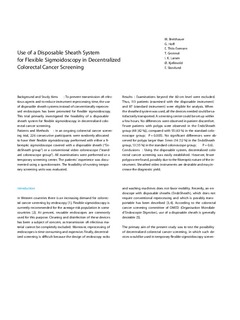| dc.description.abstract | Background and Study Aims: To prevent transmission of infectious agents and to reduce instrument reprocessing time, the use of disposable sheath systems instead of conventionally reprocessed endoscopes has been promoted for flexible sigmoidoscopy. This trial primarily investigated the feasibility of a disposable sheath system for flexible sigmoidoscopy in decentralized colorectal cancer screening.Patients and Methods: In an ongoing colorectal cancer screening trial, 226 consecutive participants were randomly allocated to have their flexible sigmoidoscopy performed with either a fiberoptic sigmoidoscope covered with a disposable sheath ("EndoSheath group" or a conventional video colonoscope ("Standard colonoscope group". All examinations were performed at a temporary screening center. The patients' experience was documented using a questionnaire. The feasibility of running temporary screening units was evaluated.Results: Examinations beyond the 60-cm level were excluded. Thus, 113 patients (examined with the disposable instrument) and 87 (standard instrument) were eligible for analysis. When the sheathed system was used, all the devices needed could be satisfactorily transported. A screening center could be set up within a few hours. No differences were observed in patient discomfort. Fewer patients with polyps were observed in the EndoSheath group (48 [42 %]), compared with 55 (63 %) in the standard colonoscope group; P = 0.005). No significant differences were observed for polyps larger than 5 mm (14 [12 %] in the EndoSheath group, 13 [15 %] in the standard colonoscope group; P = 0.6).Conclusions: Using the disposable system, decentralized colorectal cancer screening was easily established. However, fewer polyps were found, possibly due to the fiberoptic nature of the instrument. Sheathed video instruments are desirable and may increase the diagnostic yield. | |
